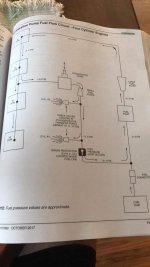No it would not.----First explain what trouble shooting if any has been done ?----Compression tested ?----Checked for strong spark ?------Made sure carburetors are clean ?-----Fuel pump diaphragm looked at.------Of course you know that the bottom 2 carburetors do not put any fuel into the motor at idle and below 1800 RPM.
i posted about this before but still didn't figure it out. Here's info below:
2003 Mercury 125 Saltwater 2 stroke (2+2) on 20ft dual console
Boat only getting up to about 4200rpms and 30mph according to gps
Compression 120+ in all 4 cyls
I've determined that it's not running on the #4 cylinder. When I pull that plug wire off, it gets up to the same speed / rpm as if it's plugged in. When I run it and pull the spark plug, it looks a little wet, but there's no color on the plug at all, as if I just took it out of the box. Changed spark plugs around to rule out getting bad plug.
Cylinder is getting spark. I have a spark light and have spark gap tester. Set gap to 7/16 and spark jumps that gap. Spark light lights up when running. Hooked up timing light and it also read same rpms as other 3 cylinders at idle.
Pulled off carb and went through it 3 times. I'm about 100% sure that there are no obstructions in carb. Got rebuild kit also, so needles are new. Float height good also. I even switched floats and needle between carb 3 and 4 to make sure float height wasn't issue, and it wasn't. Still wasn't running on #4. Also primed bulb and unscrewed drain screw on bowl to make sure fuel was in it, and it was.
Thought it maybe wasn't sucking fuel. Pulled reeds out and reeds are 100% perfect. Put my hand over carb when running and felt suction. It also drew some fuel out of the bowl when covered. I also have a steamer - I put steam in front of each carb and had someone crank motor and watched it suck steam into each carb. So suction seems good. Also rebuilt fuel pump.
Had boat on the water and up to around 3500rpms. I sprayed some fuel into that #4 carb and there was no change in speed or rpms.
Regulator is brand new. Trigger is brand new. Stator tested good with meter -did testing procedure in manual. I unhooked rev limiter and ran it and made no difference. I swapped cdms around and ran it which also made no difference. I also traced each wire for each plug that plugs into cdm module and tested continuity on each one, and all wires seem good.
My next thought was that maybe there was some water getting into that bottom cylinder. Maybe that's why the spark plug looks brand new when I pull it out because steam is cleaning it. Maybe plug looks a little wet when I pull it from water or steam. If I run it in driveway and pull out that spark plug after I shut it down, steam does come out of that spark plug hole. Not sure if that's normal or not. Also read that water intrusion will steam out a cylinder will not let it fire even if there's spark.
I pulled the exhaust side cover off of motor and replaced that gasket / water jacket. Thought maybe some water could get into cylinder from exhaust port area . But I ran it this morning and still only getting around 4-4200rpms. These motors seem simple but this is throwing me for a loop
The strange part about my run this morning was that when I first put it in and ran it, my tach said it was hitting 5000 rpms which it hasn't done since this issue began. But gps speed was still saying around 30mph. It didn't feel like it was going as fast as it should be, even though rpms were reading higher. So I pulled that plug wire off and ran it again and rpms only went up to 4200, still around 30mph. I reconnected that plug wire and ran again. Speed still around 30 and rpms stayed at 4200, not 5,000.


